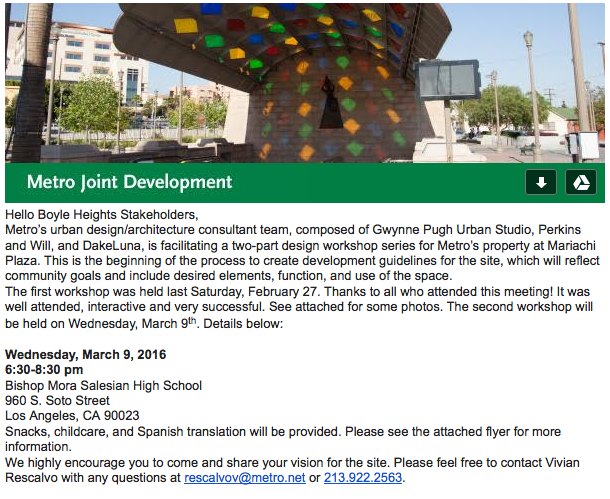Planning for Mariachi Plaza Begins Again; How it Will Tie in to Other Area Projects Remains Unclear
8:04 PM PST on March 4, 2016
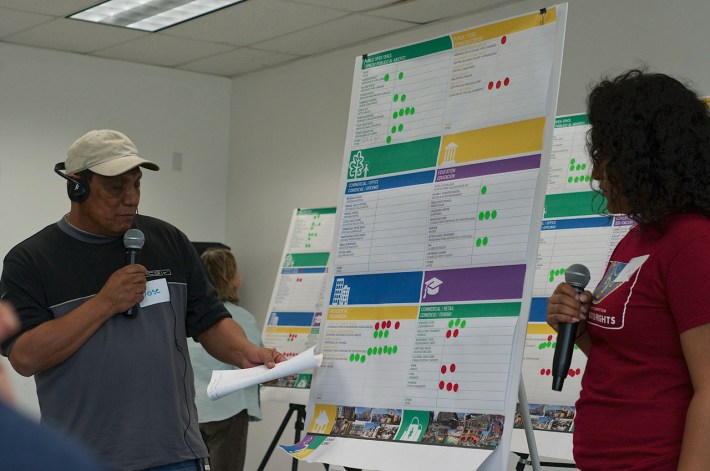
A jacuzzi.
Yes, Petronila Lozano, community member and volunteer with Union de Vecinos, repeated in Spanish, a jacuzzi with beautiful trees around it.
The Metro lot at Mariachi Plaza could be a place where both the elders and the youth of the community could relax and enjoy themselves, she winked, sketching out her ideal vision on the back of a handout: shade trees around a fountain, seating areas, a laundromat on the first floor of a three or four-story structure and affordable residences above, possibly with space reserved for a gym where seniors could dance and be fit.
Although the only one suggesting a public jacuzzi at Saturday's design workshop for the two lots at the Mariachi Plaza site (below, in orange), Lozano was not alone in wanting to see the lots be home to multiple, creative uses.
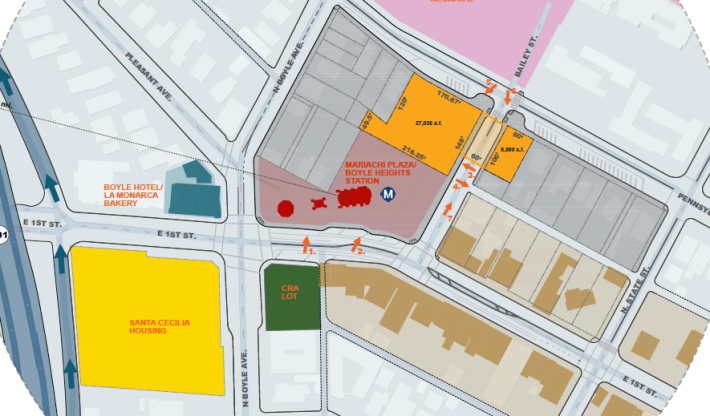
The approximately 60 stakeholders in attendance were interested in seeing everything from a cultural center to a mariachi museum to a children's playground to a space for street vendors to assisted living for seniors to affordable housing to a grocery market to after-school programming for youth to an event hall at the site.
The variety of aspirations, in some ways, pose something of a challenge to Gwynne Pugh Urban Studio, Perkins + Will, Dake Luna, the urban design/architecture consultant team Metro hired to create development guidelines for the Metro-owned lots.
In essence, it will be very hard to please everyone.
At the same time, there were a number of long-standing common threads underlying most suggestions that do offer potential developers a solid set of parameters they should be prepared to work within.
Namely, people want to see a development that speaks to and elevates the culture of the community, prioritizes the existing residents (particularly those of lower and very low income), embraces the multi-generational nature of the community, contributes to the local economy by complementing rather than competing with existing businesses (particularly along 1st Street), and serves as a gathering place, site for creative/artistic expression, and symbol of both the community's heritage and its future potential.
And it must do all these things while bolstering the local economy in the form of local jobs. One of the most pressing concerns regularly raised about the planned affordable housing projects is that the area's very low-income residents will struggle to access it (see more on why, here). People in Boyle Heights tend to work a lot, but there are few good-paying jobs in the area. "Work" for the working poor may mean juggling a few informal jobs, vending either full time or on the side, and/or putting in long hours, sometimes six days a week, only to earn enough to just get by. Formal, steady part-time jobs for youth looking to help their parents or save up money for college are practically non-existent.
An ideal project, consequently, will work to safeguard the community's cultural heritage and bolster the potential of the very people that make it so unique.
Piece of cake, right?
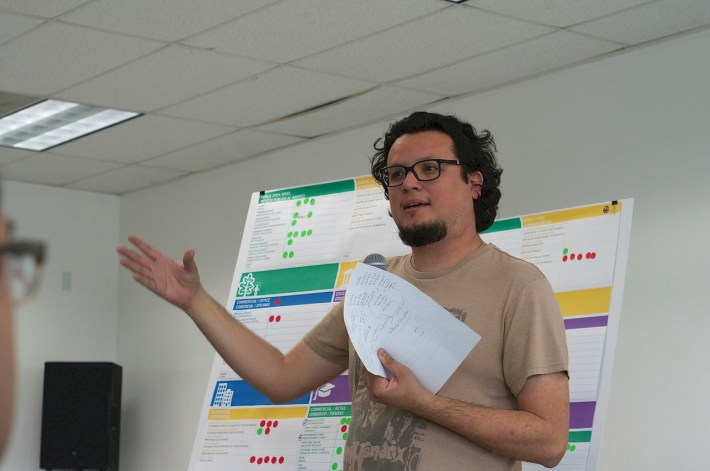
Harnessing Change
Safeguarding and strengthening a community, it must be understood, are very different from preventing it from changing.
Boyle Heights is changing.
Rapidly.
People from all walks of life within the community are more cognizant of it every day. Rents are on the rise for business owners and residential tenants alike. Houses and apartment buildings along residents' once-neglected streets are being renovated, flipped, and advertised as being located in an "up-and-coming" neighborhood to people who are, according to one local realtor speaking to the L.A. Times, "...willing to rough it out more or less, knowing that within the next three to four years, this [community] is just going to change drastically."
Even more troubling, for many, is that Boyle Heights tends to be marketed as being close to the amenities of downtown (below), with no acknowledgement of the rich arts, culture, or culinary traditions in the area itself. A brochure advertising the sale of a large site on Boyle Avenue last year actually cropped the bulk of Boyle Heights out of the map, choosing to highlight all the enticing culture, food, and fun across the river.
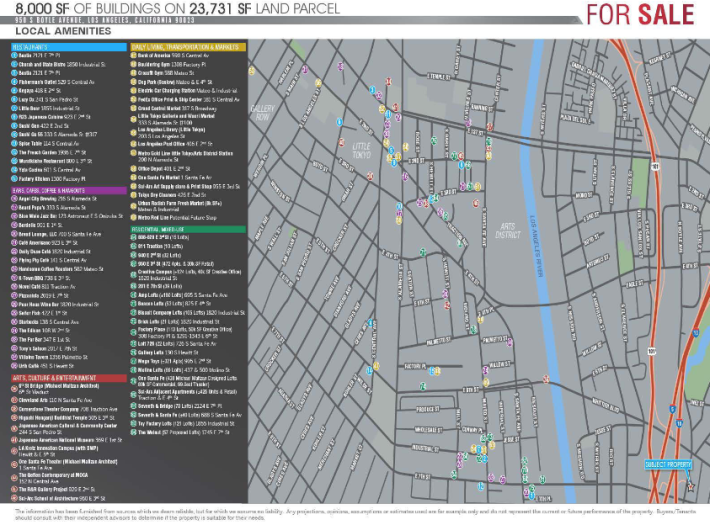
Even with all that pressure, many residents are not necessarily opposed to change, per se.
But as members of a community upon whom change has always been imposed (see that history here), they would like to have the opportunity to harness that change in a way that both celebrates who they are and allows them to stay.
To that end, these design workshops for Mariachi Plaza and other lots (like the one at 1st and Boyle) are more important than people might realize.
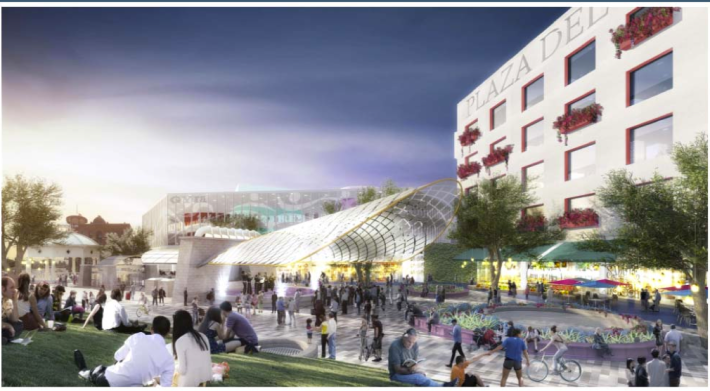
People know what they don't want and are very willing to show up to rail against being left out of the process, as they did when Metro attempted to push through a bizarre set of plans for the complete overhaul of Mariachi Plaza back in the fall of 2014 (above).
But getting residents to show up to debate what they do want is a bit harder.
And getting the city and developers to translate residents' aspirations into actual community-enhancing results on the ground is harder still.
Part of the problem (to me, at least) seems to be that there are an awful lot of projects on the table right now relative to the geographic size of Boyle Heights. But there has been very little effort to engage the community, city agencies, and developers on how these projects all could work together.
There was a workshop for the Boyle Heights Community Plan two years ago where planners talked about zoning, land use, mobility, and community goals for the district, but none of the documents handed out at the forum were ever made available online. Meaning, it would be hard for someone to educate themselves on how the city is thinking about what it would like to see for the community, offer feedback on those ideas, or think about where their own ideas or the current development projects fit into the larger context.
And even though the city is due to hold another outreach forum (probably) later this spring on the plan, it will likely be well after all of the guidelines for the pending projects have been set.
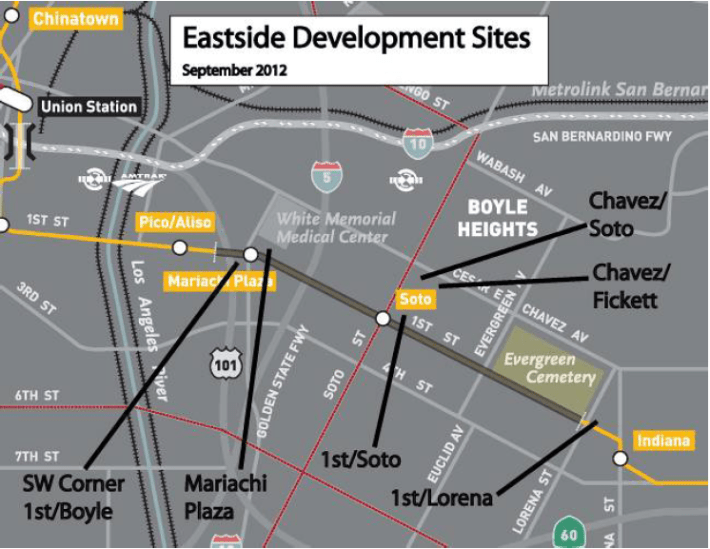
There are also several affordable housing projects going in on (mostly) Metro-owned lots along the 1st Street corridor and on Cesar Chavez (above; see full slate of Metro joint development projects here). And these, of course, are in addition to the 6th St. bridge replacement project, pending pedestrian improvements along Cesar Chavez, the next phases of the Eastside Access project (here, here), and future improvements near the elementary schools on Breed and Sheridan Streets.
Last summer, the affordable housing developers worked hard to engage stakeholders on how commercial spaces in their structures could be used to the community's advantage. But there has yet to be any public discussion on the part of Metro or the city of how plans for those projects will relate to any development at Mariachi Plaza. Or to the CRA-owned lot at 1st and Boyle. Or the Metro-owned lot that was previously slated to be a grocery store, at Cesar Chavez and Fickett. Or to any larger objectives for the community.
Which means that this might be the right time for the community to ask some bigger-picture questions.
Stakeholders at the meetings for the lots at both Mariachi Plaza and 1st/Boyle talked about the need for truly affordable housing, grocery markets, spaces for youth, spaces for the elderly, a laundromat, and retail spaces that accommodated very small businesses (in line with the kind seen around the community). They'll likely suggest much of the same when workshops are held regarding the Fickett site later this spring.
All of which is fantastic.
But, does the community need two grocery stores within eight blocks of each other? If it does, who should each plan to serve? Should one be more geared toward transit users and one be more full-service and geared toward families? Should one be more experimental and have space for local vendors offering healthy fare and one be more traditional? How should the context surrounding each inform the kind of market planned?
Where should centers for the elderly or youth be located to best assist those populations? Should they be separate? Or would the multi-generational foundation and cultural heritage of the community be strengthened by having them share a site where they helped each other? Is there a reason existing facilities for youth in the area are inadequate? And does the solution lay in strengthening existing facilities so as not to duplicate services or creating new ones that cater to youth in a unique way?
Could a cultural center at Mariachi Plaza be structured as a living museum that built ties with existing historic, cultural, artistic, culinary, and creative assets in the area? Could planning be coordinated to ensure land uses are complementary and do not replicate other projects or compete with existing assets?
And how can the development at Mariachi Plaza (and elsewhere) be engineered to act as a potential catalyst for local economic growth rather than an anchor for externally-driven change? Is there a way to bring in entertainment (movie theater, performance hall, etc.) or retail that is in harmony with consumer needs, employs local residents, creates space for local artists to innovate, and also entices people to explore neighboring businesses along 1st St. or Cesar Chavez so that those corridors grow and thrive together?
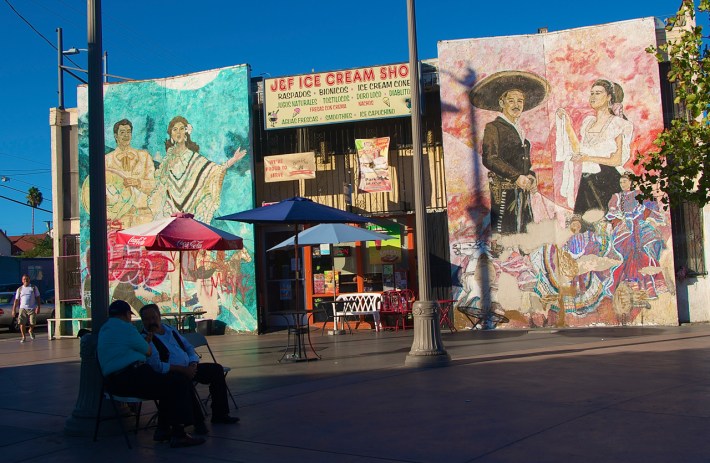
What to do with all those questions: the Leimert Park Village model
This is not as out-there a set of questions as it might appear to be.
Over the past couple of years, stakeholders in the historically African-American community of Leimert Park Village (LPV) have asked themselves these and many other questions as part of their 20/20 Vision Initiative effort.
They had to.
They could see the change the opening of the Leimert Park station was likely to bring with the completion of the Crenshaw/LAX rail line in 2020. And they were pretty sure that if they didn't find a way to lay a foundation in which an economy driven by black creatives could thrive, the very people that made Leimert Park so special wouldn't be there to witness the train's arrival.
As a result, every week for the past two years, stakeholders have met to develop an overarching vision for the area and figure out what they would need to do to make their vision a reality. Their strategy has been to court investors looking to build partnerships with local artists and cultural caretakers, carve out supportive spaces for African-American creatives to do innovative and economically viable work, and reclaim public spaces in community-specific ways (like the People St plaza project, where Adinkra symbols dot the surface of 43rd Place; the site is regularly used for cultural celebrations).
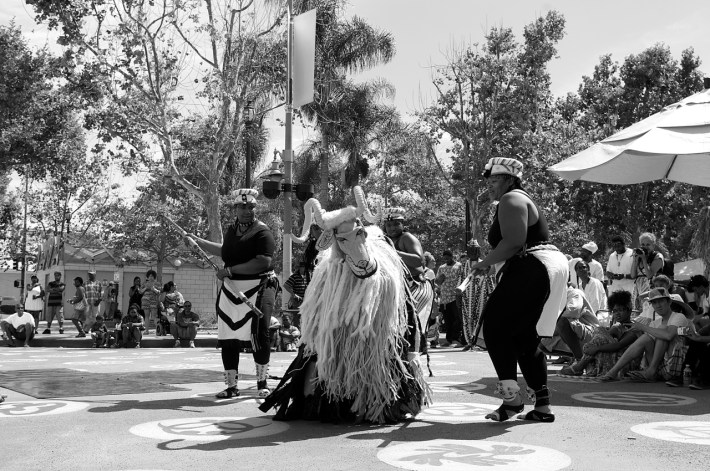
At their last design charrette, stakeholders debated plans for a cultural center, artist live-work spaces, production studios, and a smattering of retail to be built on two lots behind the Vision Theater. [More background on that project can be found here] But because actual construction is some time away, they are looking to support black entrepreneurs in the nearer-term via a "Shark Tank"-style project.
Their efforts have not stopped rents or home values from rising in the area. But the 20/20 Vision Initiative has given some in the community a sense they have at least a little more control over the future. And their efforts have helped reinvigorate the community from within. There are very few weekends (and increasingly, weeknights) when the plaza and the surrounding venues are not bustling with cultural events or other activities -- residents have been eager to be part of the change they themselves are helping to create.
Replicating what the LPV stakeholders have managed to do in a lower-income community like Boyle Heights is not easy. For one, many of the LPV stakeholders helping steer the initiative have a background in urban planning and have both time and resources they can dedicate to the cause. For another, in the heart of the village, you have a few key venues that are owned by members of the community which are serving as the anchor for development, even as everything changes around them. In that vein, there are still real opportunities to plan for the future of the village because the construction of the station has not yet been completed.
That said, the bigger-picture approach to development is still worth considering for Boyle Heights. With so many of the pending projects being linked to the city (rather than solely to a private developer that has little obligation to the community, as in the case of the Sears building), there is a real opportunity to try to ensure that the projects that do break ground benefit existing residents in a more strategic way.
Unfortunately for resident Petronila Lozano, those benefits will likely not include an all-ages outdoor jacuzzi.
But you never know.
* * *
A second meeting on Mariachi Plaza will be held on March 9 at Salesian High School, from 6:30 to 8:30 p.m. The urban design/architecture consultant team of Gwynne Pugh Urban Studio, Perkins + Will, and DakeLuna will be offering participants a synthesis of the input gathered at last Saturday's wokshop and working with participants to finalize the guidelines developers will need to use when creating proposals for the site (details below). There will also be a follow-up meeting on the future of the CRA-owned lot at 1st/Boyle at 7 p.m. on Wednesday, March 16th, at Boyle Heights City Hall.
Sahra is Communities Editor for Streetsblog L.A., covering the intersection of mobility with race, class, history, representation, policing, housing, health, culture, community, and access to the public space in Boyle Heights and South Central Los Angeles.
Stay in touch
Sign up for our free newsletter
More from Streetsblog Los Angeles
Metro Board Funds Free Student Transit Pass Program through July 2025
Metro student free passes funded another year - plus other updates from today's Metro board meeting
Eyes on the Street: New Lincoln Park Avenue Bike Lanes
The recently installed 1.25-mile long bikeway spans Lincoln Park Avenue, Flora Avenue, and Sierra Street - it's arguably the first new bike facility of the Measure HLA era
